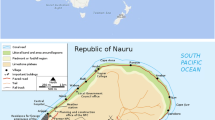Abstract
Using the example of an industrial site in Edmonton, Alberta, this paper argues that industrial ruins represent instantiations of abstract abandonment, a kind of real abstraction that directly articulates to the logic of capital. Drawing from excavations of the industrial ruins of Mill Creek Ravine, one of the first industrial areas in Edmonton, this paper reveals how sites of abstract abandonment congeal critical histories of both abandonment and its afterlives. The history of these ruins, and the communities that emerged after they were abandoned materialize the failures of capitalist fantasies, as well as the sprouts that grow in its cracks.

Similar content being viewed by others
Data Availability
The author confirms that the data supporting the findings of this study are available within the article and its supplementary materials.
References
Adorno, T. and Horkheimer, M. (1997). Dialectic of Enlightenment. Stanford University Press, Palo Alto.
Anonymous. (1902a). The Vogel Meat and Packing Co. Edmonton Bulletin. Edmonton, AB., December 12, p. 4. <www.newspapers.com>, Accessed June 6, 2022.
Anonymous. (1902b). Annual Board of Trade Meeting. Edmonton Bulletin. Edmonton, AB., February 28, p. 5. <www.peel.library.ualberta.ca>, Accessed June 6, 2022.
Anonymous. (1902c). Advertisement for Vogel Meat and Packing Co. Edmonton Bulletin. Edmonton, AB., December 19, p. 9. <www.peel.library.ualberta.ca>, Accessed June 6, 2022.
Anonymous. (1903). Locals. Strathcona Plaindealer. Edmonton, AB., July 10, p. 5. <www.peel.library.ualberta.ca>, Accessed December 4, 2018.
Anonymous. (1908). More Facts About Alberta Hogs. Edmonton Journal. Edmonton, AB., p. 1. <www.newspapers.com>, Accessed June 6, 2022.
Anonymous.(1918). Edmonton, A Garden City. Edmonton Bulletin. Edmonton, AB., p. 1. <www.peel.library.ualberta.ca>, Accessed June 6, 2022.
Benjamin, W. (1977). The Origin of German Tragic Drama. New Left Books, London.
Benjamin, W. and Tiedemann, R. (1999). The Arcades Project. Belknap, Cambridge MA.
Boym, S. (2003). Tatlin, or, Ruinophilia. Cabinet 28. <https://www.cabinetmagazine.org/issues/28/boym2.php>, Accessed June 6, 2022.
Chakrabarty, D. (2007). Provincializing Europe. Princeton University Press, Princeton, NJ.
Dawdy, S. (2010). Clockpunk anthropology and the ruins of modernity. Current Anthropology 52(6): 761-793.
DeSilvey, C. and Edensor, T. (2012). Reckoning with ruins. Human Geography 37(4): 465-485.
Evans, S. (2004). The Bar U and Canadian Ranching History. University of Calgary Press, Calgary.
Gilpin, J. F. (1978). The City of Strathcona, 1891–1912: "We see just ahead the glory of the sun in His might". Master's thesis. Department of History, University of Alberta, Edmonton.
Gonzalez-Ruibal, A. (2008). Time to destroy: an archaeology of supermodernity. Current Anthropology 49:247–279.
Gonzalez-Ruibal, A. (2019). An Archaeology of the Contemporary Era. Routledge, London.
Gordillo, G. (2014). Rubble: The Afterlife of Destruction. Duke University Press, Durham, NC.
Kautsky, K. (1994). Marxism, Revolution, and Democracy. Transaction, London.
Lefebvre, H. (2009). State, Space, World: Selected Essays. Brenner, N. and Elden, S. (trans.), Moore, G. and Brenner, N. (eds.). University of Minnesota Press, Minneapolis, MN.
Lukacs, G. (1971). History of Class Consciousness. MIT Press, Cambridge.
MacLachlan, I. (2001). Kill and Chill: Restructuring Canada’s Beef Commodity Chain. University of Toronto Press, Toronto.
Marx, K. (1977). Capital: A Critique of Political Economy. Vintage, London.
Moore, J. (2016). The Rise of Cheap Nature. In Moore, J. (ed.), Anthropocene or Capitalocene?: Nature, history and the Crisis of Capitalism. PM Press, Oakland, pp. 78–116.
De Sola-Morales, I. (1995). Terrain vague. In Davidson, C. (ed.), AnyPlace. MIT Press, Cambridge, MA, pp. 118–123.
Moterjemi, Y. (2014). Encyclopaedia of Food Safety. Elsevier, Amsterdam.
Murphy, M. (2013). Chemical infrastructures of the St. Clair River. In Boudia, S. and Jas, N. (eds.), Toxicants, Health, and Regulation since 1945. Routledge, London, pp. 99–113.
Murthy, V. 2022. The Politics of Time in China and Japan. London, Routledge.
Nixon, R. (2010). Slow Violence and the Environmentalism of the Poor. Harvard University Press, Cambridge, MA.
Pacyga, D. (2015). Slaughterhouse: Chicago’s Union Stockyard and the World It Made. University of Chicago Press, Chicago.
Papadopoulos D. (2009). The hidden qualities of dereliction. MPhil thesis, Open University. <https://doi.org/10.21954/ou.ro.0001004a>.
Postone, M. (1993). Time, Labor, and Social Domination. Cambridge University Press, Cambridge.
Purcell, M. (2013). Henri Lefebvre and the right to the city. Journal of Urban Affairs 36(1):141–154.
Author information
Authors and Affiliations
Corresponding author
Ethics declarations
Conflict of Interest
The author declares that there is no conflict of interest.
Additional information
Publisher's Note
Springer Nature remains neutral with regard to jurisdictional claims in published maps and institutional affiliations.
Rights and permissions
Springer Nature or its licensor (e.g. a society or other partner) holds exclusive rights to this article under a publishing agreement with the author(s) or other rightsholder(s); author self-archiving of the accepted manuscript version of this article is solely governed by the terms of such publishing agreement and applicable law.
About this article
Cite this article
Stewart, H.E. Abandonment: The Two Sides of Industrial Decay in Mill Creek Ravine. Int J Histor Archaeol 28, 86–100 (2024). https://doi.org/10.1007/s10761-022-00681-4
Accepted:
Published:
Issue Date:
DOI: https://doi.org/10.1007/s10761-022-00681-4




